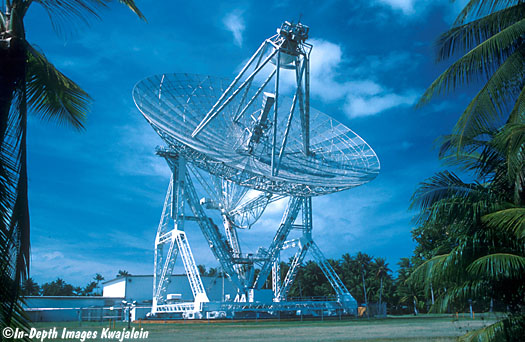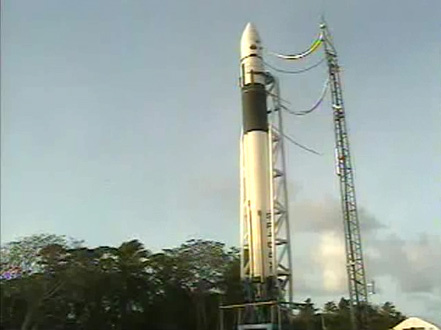Yet another blog detailing life on a tiny speck of land in the middle of the Pacific Ocean.
Thursday, March 31, 2011
Best thing ever.
Best thing ever: Setting up a video-conferencing link to a military base in central Alaska, and watching everyone there walk in wearing massive huge heavy winter coats and gloves, covered in snow. We, wearing board shorts, aloha shirts and flip-flops, tried to stay out of frame. :D
Saturday, March 12, 2011
Why didn't the tsunami hit us?
Aside from the sounding of sirens and an almost token "evacuation" of people to the upper floors of buildings, we saw absolutely no effect from the Tsunami emanating from Japan. This wasn't unexpected, atolls such as ours aren't usually at high risk for them.
For a tsunami to really build up you want two things; a slow, even rise up from the sea floor, (like a continental shelf) and a long, straight (or even slightly U-shaped) coastline to focus the wave. We don't have any of that.
Once you get past our little coral reef, the ocean floor drops off in an almost purely vertical wall, all the way to the 6,000 foot deep sea bed. Our coastline is also jagged and uneven, which would help break up any sort of wave that was able to build up. And while we're large by atoll standards, we're very small by oceanic standards, so small that any wave just goes around us without noticing.
That's not to say we haven't seen some slightly unusual side effects from this ordeal.
We're serviced by Continental Airlines once a day; On even days the airplane goes from Honolulu > Majuro > Kwajalein > Pohnpei > Guam, and on odd days it makes the reverse trip. On Friday, the airplane was already delayed for a couple of hours due to mechanical issues, but then just as it landed here on Kwaj, they made the decision that it was going to skip Majuro due to concerns of the possibility of a tidal wave. So the airplane went directly to Honolulu, and everyone who was coming from the east and desined for Majuro was kicked off the plane here at Kwaj.
We're not quite sure what to do with them at this point. Many of them are foreign nationals and as this is a military base, they are very much not allowed to roam around. We've been putting them up in one of the multi-purpose buildings, but the next flight isn't until Tuesday. There's talk of putting them up at Ebeye, but the cots in a big room that they've got them in here is probably nicer then any accommodations on Ebeye.
At this point, it's mostly the airline's call. They could send them back to Guam today, where at least they can be put into proper hotels and have some communication with the outside world. No one's really sure what will happen, but it sure is a weird side-effect of an earthquake 4,000 miles away.
For a tsunami to really build up you want two things; a slow, even rise up from the sea floor, (like a continental shelf) and a long, straight (or even slightly U-shaped) coastline to focus the wave. We don't have any of that.
Once you get past our little coral reef, the ocean floor drops off in an almost purely vertical wall, all the way to the 6,000 foot deep sea bed. Our coastline is also jagged and uneven, which would help break up any sort of wave that was able to build up. And while we're large by atoll standards, we're very small by oceanic standards, so small that any wave just goes around us without noticing.
That's not to say we haven't seen some slightly unusual side effects from this ordeal.
We're serviced by Continental Airlines once a day; On even days the airplane goes from Honolulu > Majuro > Kwajalein > Pohnpei > Guam, and on odd days it makes the reverse trip. On Friday, the airplane was already delayed for a couple of hours due to mechanical issues, but then just as it landed here on Kwaj, they made the decision that it was going to skip Majuro due to concerns of the possibility of a tidal wave. So the airplane went directly to Honolulu, and everyone who was coming from the east and desined for Majuro was kicked off the plane here at Kwaj.
We're not quite sure what to do with them at this point. Many of them are foreign nationals and as this is a military base, they are very much not allowed to roam around. We've been putting them up in one of the multi-purpose buildings, but the next flight isn't until Tuesday. There's talk of putting them up at Ebeye, but the cots in a big room that they've got them in here is probably nicer then any accommodations on Ebeye.
At this point, it's mostly the airline's call. They could send them back to Guam today, where at least they can be put into proper hotels and have some communication with the outside world. No one's really sure what will happen, but it sure is a weird side-effect of an earthquake 4,000 miles away.
Friday, March 11, 2011
Tsunami warning
Air raid sirens are going off and we're getting the evacuation order.
*edit* Ah well, false alarm.
*edit* Ah well, false alarm.
Saturday, March 5, 2011
The Basics, Pt 2: Why?
Being able to get a job living on a tropical atoll in the middle of the pacific ocean is all well and good for me, and the others that work here, but what does the US Army see in this place? Why are they here? Why are they paying me to be here?
To put it simply, we are here for target practice.

Test warheads from an LGM-118A Peacekeeper ICBM landing in the atoll
In decades past, this atoll was used for calibration and tracking research for ICBMs (Inter-Continental Ballistic Missiles). Missiles would be launched from various missile bases in the continental United States, pointed in our direction. Once they landed here, we'd tell the people in the US exactly where the dummy warheads landed, essentially to allow them to dial in their aim.
These days, ICBMs are so accurate that it's largely pointless; the fact that they usually carry nuclear warheads means that anything within half a mile is probably good enough.
So the roll of Kwajalein has changed a good deal over the years; moving from it's initial roll as a logistics staging point during World War 2 to it's current position as one of the locations in the Ballistic Missile Defense Test site. These days, most of the work is in cutting-edge radar, optics, telemetry and space research.

The majority of the day-to-day stuff involves lots of tracking and monitoring of "space junk", the various detritus that's been left in orbit by decades of rocket launches around the world. And while most of the work is looking at stuff others have launched, occasionally we will launch something of our own.

In addition to the various things the Army launches from here, Space-X has their launch facility on one of the islands in the atoll. They're not as active out here as they used to be, but they still maintain a presence and continue to rent hanger space, and maintain their equipment.
And all of those activities; Launching rockets, landing rockets, basting out megawatts of electromagnetic radiation, they share a common requirement. You want them to happen as far away from anything else as they can possibly be.
And that's why they're here. Because this little spec of land, surrounded by 2,000 miles of ocean on all sides, is as far away from anything else as they can possibly be.
To put it simply, we are here for target practice.

Test warheads from an LGM-118A Peacekeeper ICBM landing in the atoll
In decades past, this atoll was used for calibration and tracking research for ICBMs (Inter-Continental Ballistic Missiles). Missiles would be launched from various missile bases in the continental United States, pointed in our direction. Once they landed here, we'd tell the people in the US exactly where the dummy warheads landed, essentially to allow them to dial in their aim.
These days, ICBMs are so accurate that it's largely pointless; the fact that they usually carry nuclear warheads means that anything within half a mile is probably good enough.
So the roll of Kwajalein has changed a good deal over the years; moving from it's initial roll as a logistics staging point during World War 2 to it's current position as one of the locations in the Ballistic Missile Defense Test site. These days, most of the work is in cutting-edge radar, optics, telemetry and space research.

The majority of the day-to-day stuff involves lots of tracking and monitoring of "space junk", the various detritus that's been left in orbit by decades of rocket launches around the world. And while most of the work is looking at stuff others have launched, occasionally we will launch something of our own.

In addition to the various things the Army launches from here, Space-X has their launch facility on one of the islands in the atoll. They're not as active out here as they used to be, but they still maintain a presence and continue to rent hanger space, and maintain their equipment.
And all of those activities; Launching rockets, landing rockets, basting out megawatts of electromagnetic radiation, they share a common requirement. You want them to happen as far away from anything else as they can possibly be.
And that's why they're here. Because this little spec of land, surrounded by 2,000 miles of ocean on all sides, is as far away from anything else as they can possibly be.
Subscribe to:
Posts (Atom)